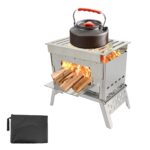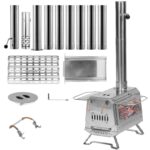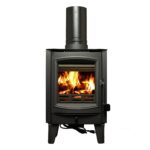
Introduction to Portable Wood Burning Stoves
Portable wood burning stoves have emerged as essential tools for outdoor enthusiasts, particularly campers seeking a sustainable and efficient cooking method. These stoves, designed for convenient transport and easy assembly, use wood as a primary fuel source, allowing users to harness nature’s resources in various camping environments. Their compact design makes them suitable for packing into camping gear, facilitating a seamless transition from regular stoves to a more environmentally friendly alternative.
The primary purpose of portable wood burning stoves is to provide a reliable means for cooking meals and boiling water while engaging in outdoor activities. Unlike traditional gas or propane stoves, which require specific fuel canisters, wood burning stoves rely on readily available materials. This self-sufficiency extends the duration of camping trips, as adventurers can gather firewood instead of carrying fuel. Moreover, the experience of cooking over an open flame adds an authentic touch to the camping experience, enhancing the connection to nature.
Benefits of using portable wood burning stoves include efficient heat output, versatility, and a low environmental impact. These stoves are often constructed from durable materials that allow for high-temperature cooking without compromising performance. The use of wood fuels, which can be sourced directly from the surrounding environment, minimizes reliance on manufactured fuels, aligning with the values of eco-conscious campers. Additionally, many models feature adjustable airflow and serve multiple functions, ranging from cooking to providing warmth during chilly nights.
The growing popularity of portable wood burning stoves among outdoor enthusiasts reflects a broader trend towards sustainability in camping practices. As travelers become increasingly aware of environmental impacts, the shift to renewable energy sources is gaining traction. Consequently, wood burning stoves are positioned as not only practical outdoor cooking solutions but also as components of responsible and eco-friendly camping.
Advantages of Using Wood Burning Stoves
Wood burning stoves have garnered significant attention in the camping community due to their numerous advantages. One of the primary benefits is their sustainability. Unlike traditional fossil fuels, wood is a renewable resource, especially when sourced responsibly. This means that campers can use their stoves with minimal environmental impact, fostering a more eco-friendly approach to outdoor cooking and heating.
Another notable advantage of wood burning stoves is the accessibility of fuel. In many camping sites, wood is readily available, whether it’s fallen branches or designated firewood supplies. This readily accessible fuel source minimizes the need for carrying heavy propane tanks or other fuel types, allowing campers to travel lighter and enjoy nature without reliance on commercial fuel products. Additionally, by using locally sourced wood, campers can significantly reduce their carbon footprint while off the grid.
Cost-effectiveness is also a strong point when considering wood burning stoves. Once purchased, utilizing wood as a fuel source can translate into long-term savings since wood is often less expensive than other fuel options. Campers can enjoy delicious meals and stay warm without constantly worrying about the rising costs of fuel, making wood burning stoves an economically attractive choice for outdoor enthusiasts.
Moreover, the multifunctionality of wood burning stoves adds another layer of appeal. These stoves can be used for cooking meals, boiling water, and providing heat. This versatility enhances the camping experience, allowing adventurers to enjoy a combination of warmth and nourishment all in one compact unit. The ability to create an authentic cooking experience in nature, along with heating capabilities, makes wood burning stoves a preferable option for many campers.
In conclusion, wood burning stoves offer a range of benefits, including sustainability, fuel availability, cost-effectiveness, and multifunctionality, making them an excellent choice for outdoor cooking and heating needs.
Key Features to Consider When Choosing a Portable Wood Burning Stove
When selecting a portable wood burning stove for camping, there are several key features that should guide your decision-making process. One of the foremost considerations is the size of the stove. A compact and lightweight design is essential for ease of transport, especially in situations where space is limited. Opting for a model that fits well within your camping gear can significantly enhance overall convenience. The weight of the stove should also be assessed, as a lighter model will be easier to carry during hiking or trekking scenarios.
The material used in the construction of the stove plays a significant role in its durability and performance. Stainless steel and other high-quality metals are often preferred for their ability to withstand high temperatures and resist corrosion. Assessing the stove’s design and material will ensure you make a robust choice that can withstand the rigors of outdoor cooking.
Efficiency is another critical factor, as it determines how effectively the stove will generate heat and cook food. Look for models that promote efficient combustion, thereby maximizing fuel usage while minimizing smoke output. Additionally, consider ease of assembly and disassembly; a stove that is user-friendly will allow you to set up quickly and start cooking with minimal hassle.
Furthermore, air control features are essential for adjusting the flame intensity and cooking temperature. Stoves with adjustable air vents or dampers offer better control over the burning process, aiding in both cooking and heating capabilities. When evaluating these features, it is advisable to align them with your specific camping needs. For example, if you primarily cook for a small group, a stove with features that offer precise temperature control will enhance your cooking experience significantly.
Best Portable Wood Burning Stoves on the Market
When considering portable wood burning stoves for camping, it is essential to select a model that meets your specific needs while offering reliability and efficiency. Here are some of the most commendable options available, showcasing various features and benefits.
The Solo Stove Lite is a popular choice among campers due to its lightweight design and efficient burning capabilities. Constructed from durable stainless steel, it utilizes a unique double-wall technology that enhances airflow for a more complete combustion process. This feature not only maximizes heat output but also minimizes smoke, ensuring a pleasant cooking experience in the great outdoors.
Another noteworthy model is the Camp Chef Alpine Heavy Duty stove. This robust option is characterized by its ample cooking area and strong dual burner system. Designed for those who prefer a more traditional stove experience with wood, it excels in performance and durability. Its adjustable heat controls allow users to fine-tune the cooking temperature, catering to various cooking styles.
For a compact and efficient option, the Hiker Pro portable stove stands out. This model features a streamlined design that allows for easy setup and packing. It employs a unique air intake system that enhances combustion efficiency, making it ideal for quick meals while preserving fuel resources. Suitable for solo campers or small groups, this stove offers convenience without compromising on performance.
One cannot overlook the Winnerwell Woodlander stove, which combines portability with rugged construction. Featuring stainless steel components, this stove not only efficiently transfers heat but also lasts through many camping seasons. Its collapsible design makes it easy to transport, while the chimney pipe ensures smoke is directed away from the cooking area, enhancing safety.
These portable wood burning stoves represent a variety of choices for camping enthusiasts. By evaluating your specific requirements and preferences, you can find the perfect stove that aligns with your outdoor cooking needs. Each model has its unique strengths, ensuring that there is an ideal option for every camper.
How to Safely Use a Portable Wood Burning Stove
When utilizing a portable wood burning stove while camping, safety should always be the foremost priority. These stoves not only provide warmth and cooking capabilities but also pose specific risks if not used correctly. To ensure a secure experience, it is critical to adhere to recommended safety practices throughout your camping trip.
The first step in safely using a portable wood burning stove is to select an appropriate setup location. Ideally, this area should be on level ground, away from overhanging branches, dry leaves, or other flammable materials. Additionally, creating a buffer zone of at least three feet around the stove can help minimize the risk of accidental fires. Always check for local regulations regarding fire safety in the area to understand any restrictions on stove usage.
Proper fuel selection is another integral factor. While these stoves can burn a variety of materials, ensure you are utilizing dry, seasoned wood to minimize smoke and hazardous emissions. Avoid burning trash or treated wood, as these can release harmful chemicals. It is also advisable to carry adequate fuel to avoid running out and becoming tempted to use unsuitable alternatives.
Fire containment is vital for both safety and environmental protection. Always ensure that the burning material is contained within the stove’s designated area. Once the cooking or heating is complete, allow the stove to cool down completely before handling it or packing it away, which prevents potential burns or accidents.
Lastly, practice environmental responsibility by making sure all ash and used fuel are disposed of properly, following Leave No Trace principles. By adhering to these guidelines, campers can enjoy the benefits of portable wood burning stoves while minimizing safety hazards and protecting natural surroundings.
Tips for Cooking with a Wood Burning Stove
Cooking with a wood burning stove can be a rewarding experience, especially when camping in the great outdoors. To maximize your culinary endeavors, it is essential to consider meal planning, cooking techniques, cookware, and suitable recipes tailored for wood burning stoves. Planning meals in advance is crucial, as it allows for efficient use of ingredients and reduces food waste. Opt for simple, hearty meals that require minimal preparation, such as stews or one-pot dishes. These types of meals not only save time but can also take advantage of the heat retention properties of the stove.
When utilizing a wood burning stove, mastering various cooking techniques can greatly enhance your culinary skills. For instance, cooking over an open flame can impart a unique smoky flavor to dishes, while using the stove’s oven function allows for baking bread or desserts. Employing cast iron cookware is highly recommended due to its excellent heat distribution and retention capabilities. Additionally, investing in a durable and lightweight pot set designed for camping can significantly improve your cooking experience.
There are many recipes particularly suited for wood burning stoves, ranging from grilled meats to vegetable skewers. Marinating proteins beforehand can enhance flavor and tenderness. Utilizing the heat emitted from the stove’s fire can also facilitate methods such as grilling, roasting, or slow-cooking, depending on your needs. Incorporating fresh, local ingredients can lead to delightful meals. Moreover, don’t hesitate to try cooking items like pizzas or pancakes, which can turn a standard camping trip into a gourmet experience.
By adhering to these tips, campers can enjoy not only delicious meals but also an enjoyable cooking experience with their portable wood burning stove. Proper planning and technique implementation can set the stage for memorable culinary adventures in nature.
Maintenance and Care for Your Stove
Maintaining a portable wood burning stove is crucial to ensure its longevity and efficient performance. Proper care not only enhances the stove’s lifespan but also improves its overall functionality. Regular maintenance involves cleaning, inspecting, and storing the unit correctly after use. Neglecting these practices can lead to reduced efficiency, safety hazards, and costly repairs in the future.
To clean your stove, first make sure it is completely cool before attempting any maintenance. Use a soft brush or cloth to remove any ash or residue from the combustion chamber and stovepipe. It is advisable to utilize a vacuum cleaner designed for ash removal for a more thorough clean. Check for any signs of soot buildup; if present, a more intensive cleaning may be necessary. When cleaning components, avoid using harsh chemicals as they can damage the stove’s materials.
Inspect the various parts of the stove for any signs of wear or damage. Pay close attention to seals and gaskets, as degraded seals can lead to air leakages, affecting burn efficiency. If any segments appear compromised, consider repairing or replacing them as needed. Keeping spare parts on hand may be beneficial as it reduces downtime during camping excursions.
Proper storage is equally vital for the maintenance of a portable wood burning stove. When not in use, ensure that your stove is stored in a dry and cool place, protected from moisture that could lead to rust or corrosion. A protective cover or bag can safeguard the stove from the elements and keep it in optimal condition. If you notice any rust forming, gently sand it away before applying a high-temperature paint to prevent further corrosion.
In conclusion, regular maintenance and caring for your portable wood burning stove enhance its performance, safety, and longevity. By adhering to these practices, users can enjoy reliable and efficient heating while camping, ensuring their stove serves them well for many outings to come.
Environmental Impacts of Wood Burning Stoves
Wood burning stoves offer a practical solution for campers seeking to enjoy the ambiance of a fire while preparing meals. However, it is essential to recognize the environmental implications associated with their use. One significant concern is the emissions generated from burning wood. When wood is combusted, it releases particulate matter and volatile organic compounds (VOCs) into the atmosphere. These emissions can contribute to air pollution, affecting both local air quality and broader climate change issues. It is crucial for campers to opt for well-seasoned wood, which produces fewer emissions compared to green or wet wood, ensuring a cleaner burn.
Another vital aspect revolves around deforestation, which poses a considerable threat to many ecosystems. While collecting firewood for camping might seem innocent, overharvesting can lead to habitat destruction and loss of biodiversity. Campers should prioritize sustainable practices, such as gathering fallen branches or utilizing designated firewood sources that adhere to responsible harvesting guidelines. Additionally, participants in outdoor activities can support local initiatives aimed at forest preservation, thereby contributing to the maintenance of natural habitats.
Responsible wood sourcing further enhances the eco-friendliness of using wood burning stoves. Eco-conscious campers can opt for certified sustainable wood products, often available through local suppliers. These practices not only minimize the ecological footprint of camping but also foster a greater sense of stewardship over the environment. By integrating sustainable wood sourcing and mindful consumption into their camping routines, users of wood burning stoves can enjoy their outdoor experiences without compromising the health of the natural world. Ultimately, the adoption of responsible camping practices will ensure that future generations can continue to enjoy the tranquility of nature while being aware of and addressing the environmental challenges that come with wood burning.
Conclusion and Final Thoughts
In this guide, we explored the myriad advantages of utilizing portable wood burning stoves for camping. Emphasizing both practicality and efficiency, these stoves offer a sustainable solution that enhances outdoor cooking experiences. One of the most significant benefits is their use of readily available natural resources, allowing campers to minimize their environmental impact while enjoying the great outdoors. By utilizing wood as fuel, campers can reduce reliance on propane or gas, fostering a more sustainable camping habit.
The versatility of portable wood burning stoves is another critical aspect worth noting. These stoves are designed to accommodate various cooking styles, whether for simmering, boiling, or grilling. The ability to harness the heat of burning wood opens up a world of culinary possibilities in a camping setting. Furthermore, witnessing an open flame creates an inviting atmosphere that can enhance the overall camping experience, making mealtime more than just a necessity but a cherished moment shared among friends and family.
Moreover, the compact and lightweight design of modern portable wood burning stoves ensures easy transport and setup, allowing enthusiasts to focus on the adventure rather than cumbersome equipment. This ease of use is especially beneficial for families or groups embarking on longer journeys into the wilderness. Prospective campers are encouraged to select models that offer robust construction yet remain lightweight, striking the ideal balance between durability and portability.
As camping continues to gain popularity, the choice of a portable wood burning stove represents an investment in quality experiences. Their unique combination of eco-friendliness, cooking versatility, and portability makes them an excellent addition to any camper’s gear. For your next outdoor endeavor, consider incorporating a portable wood burning stove into your setup as it could transform your culinary adventure under the stars.





